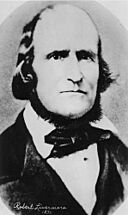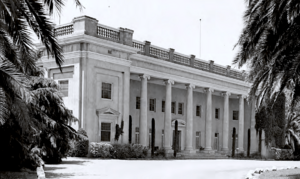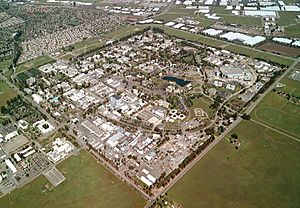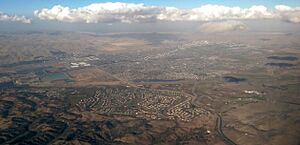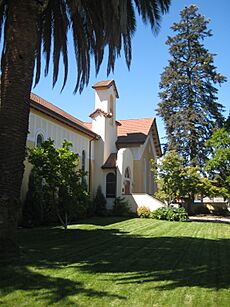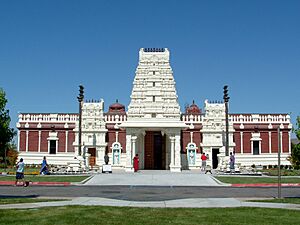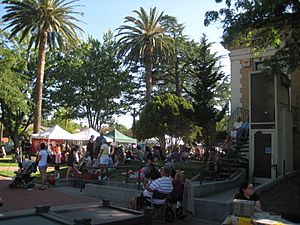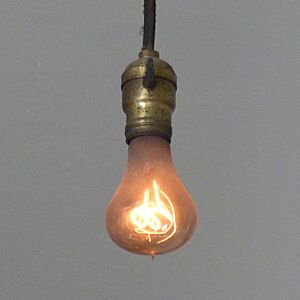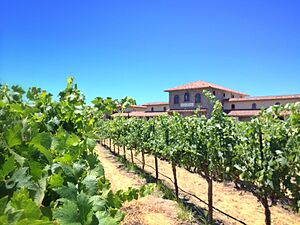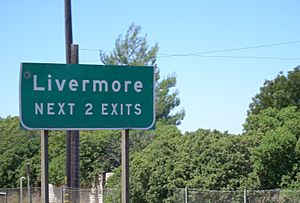Livermore, California facts for kids
Quick facts for kids
Livermore
|
|||
|---|---|---|---|

Downtown Livermore
|
|||
|
|||
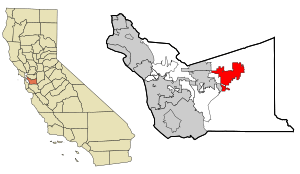
Location of Livermore in Alameda County, California
|
|||
| Country | |||
| State | California | ||
| County | Alameda | ||
| Established | 1869 | ||
| Incorporated | April 1, 1876 | ||
| Named for | Robert Livermore | ||
| Government | |||
| • Type | Council–manager | ||
| Area | |||
| • City | 26.45 sq mi (68.50 km2) | ||
| • Land | 26.45 sq mi (68.49 km2) | ||
| • Water | 0.00 sq mi (0.01 km2) 0.010% | ||
| • Metro | 2,474 sq mi (6,410 km2) | ||
| Elevation | 495 ft (151 m) | ||
| Population
(2020)
|
|||
| • City | 87,955 | ||
| • Rank | 100th in California (2023) | ||
| • Density | 3,325.3/sq mi (1,284.01/km2) | ||
| • Urban | 240,381 (US: 167th) | ||
| • Urban density | 3,683.5/sq mi (1,422.2/km2) | ||
| Time zone | UTC−8 (Pacific) | ||
| • Summer (DST) | UTC−7 (PDT) | ||
| ZIP codes |
94550, 94551
|
||
| Area code | 925 | ||
| FIPS code | 06-41992 | ||
| GNIS feature IDs | 277542, 2410848 | ||
Livermore is a city in Alameda County, California. In 2020, about 87,955 people lived there. Livermore is the largest city in the Tri-Valley area. It is located on the eastern side of California's San Francisco Bay Area. This makes it the easternmost city in that region.
Livermore was once a railroad town. It was named after Robert Livermore, a local rancher from the 1840s. The city is home to the Lawrence Livermore National Laboratory. The chemical element livermorium is even named after this lab! Livermore also hosts the California site of Sandia National Laboratories. These labs are very important for science and technology.
On the south side of Livermore, you'll find many local vineyards. The downtown area is also being updated and improved. The United States Census Bureau says that Livermore is the main city in the Tri-Valley urban area. This area also includes Pleasanton and Dublin. In 2020, about 240,381 people lived in this urban area.
Contents
- Discovering Livermore's Past
- Livermore's Location and Weather
- People and Population in Livermore
- Livermore's Economy and Jobs
- Arts, Culture, and Fun in Livermore
- Parks and Recreation in Livermore
- Education in Livermore
- Getting Around Livermore
- Famous People from Livermore
- Livermore's Sister Cities
- Resources About Livermore
- See also
Discovering Livermore's Past
Early History of the Valley
Long ago, the Livermore Valley was home to the Chochenyo people. They were part of the larger Ohlone group. These native people lived in villages near water. They also had seasonal camps in the hills.
In 1772, a Spanish group led by Pedro Fages explored the valley. Later, the Spanish Mission of San Jose was built in 1797. The mission tried to bring native people into their system. But some local tribes also used the valley to plan raids against the mission.
How Livermore Grew in the 1800s
Many native people were baptized at Mission San Jose. Spanish soldiers also used the valley for travel. Sadly, diseases like measles caused many deaths in 1806. The Livermore-Amador Valley was mostly used for grazing mission animals. This helped Mission San Jose become very rich.
After the mission system changed, two large ranchos were created in 1839. These were Rancho Las Positas and Rancho Valle de San Jose. Many native groups left the mission. They tried to restart their communities in the East Bay. They often worked as laborers to survive.
Robert Livermore and the Ranchos
Robert Livermore (1799–1858) is the person the city is named after. He was from Britain. In 1839, he and Jose Noriega received a large land grant. This land, called Rancho Las Positas, became most of Livermore.
In the 1840s, Robert Livermore moved his family to the valley. He was one of the first non-native settlers. When gold was found in California in 1848, he became rich. He sold his longhorn cattle to the many hungry gold miners. His ranch became a popular stop for travelers. They were heading to Sacramento and the gold country. Because Robert Livermore offered food and shelter, the valley became known as "Livermore's Valley." It is still called the Livermore Valley today.
The City's Beginning
Robert Livermore passed away in 1858. The first small town in the valley was Laddsville. It grew around a hotel built by Alponso Ladd in 1864. Laddsville had about 75 people. It had a blacksmith, a saloon, and a general store. The first school was built in 1866.
William Mendenhall founded Livermore. He bought land in the valley in 1866. In 1869, he set aside 100 acres for a new town. He named it Livermore, honoring his friend Robert Livermore. The town was planned on November 4, 1869. It was designed as a railroad town. Mendenhall gave 20 acres to the Western Pacific Railroad. The railroad built a stop and station there in September 1869.
After a fire in 1871, Laddsville slowly joined Livermore. The railroad helped Livermore grow very fast. The city officially became a city on April 1, 1876. At that time, about 830 people lived there.
Early Industries and Life
In its early days, Livermore made money from wheat. Coal and oil found in nearby hills also helped. The Livermore Coal Company started in 1875. The town also became known for its wine. Wineries like Wente Vineyards and Concannon Vineyards started in the 1880s. Livermore's climate and soil were perfect for growing wine grapes. By 1880, vineyards were replacing wheat fields.
Private schools started in Livermore in the 1860s. The Livermore Collegiate Institute opened in 1870. Union High School, now Livermore High School, had its first graduates in 1896. By 1876, Livermore had a fire company, churches, a bank, and a library. A telephone line connected Livermore by 1886. Electric lights came in 1888.
Livermore in the 1900s
In the early 1900s, the Livermore Valley was known for its warm climate and clean air. This attracted sanitariums, which were places for medical treatment. The Livermore Sanitarium treated mental health from 1894 to 1960. The Arroyo del Valle Sanitarium treated tuberculosis from 1918 to 1960. People even used to say, "Live Longer with Livermore!"
In 1909, the Livermore Carnegie Library and Park opened. It was built with money from a special grant. As the city grew, new libraries were built. The original building became a historic center and park.
Livermore was mostly a farming town until 1945. Then, it started to become a suburb. This happened because the Lawrence Livermore National Laboratory was built in 1952. Sandia National Laboratories followed in 1956. Many people moved to Livermore from other parts of the Bay Area.
In 1942, the U.S. government bought land for the Livermore Naval Air Station. This base trained Navy pilots for World War II. After the war, the base closed in 1946. In 1952, the government created the Lawrence Livermore National Laboratory (LLNL). It was named after physicist Ernest O. Lawrence. This lab studied nuclear energy. Edward Teller helped start LLNL. In 1956, the California site of Sandia National Laboratories opened. Both LLNL and Sandia are major employers in Livermore.
Livermore's Location and Weather
What is Livermore's Geography Like?
The Livermore Valley is in the Diablo Range. This range is part of the California Coast Ranges. The valley runs east to west. It has mountain passes that connect the Bay Area to the Central Valley. These passes are used by trains and highways. The Livermore Valley is about 15 miles long and 10 miles wide.
Rivers and streams like Arroyo Mocho flow through Livermore. The city sits on top of an underground water source called the Mocho Subbasin. Livermore covers about 25.2 square miles of land. There are also several seismic areas nearby. These include the Greenville Fault.
The soil in Livermore is mostly gravel. This soil drains water very well. This gravel is also used in several mining sites outside the city. The gravelly soil and warm climate help grapes grow well. This makes the grapes very flavorful.
What is Livermore's Climate?
Livermore has a hot-summer Mediterranean climate. This means it has hot, dry summers. Winters are cool with some rain. The valley's passes guide air through the area. In summer, a strong evening wind brings cool air from the Pacific Ocean. This wind is strong and steady. It helps power wind turbines in the Altamont Pass.
From June to September, it is very dry. The skies are usually clear. Sometimes, in late summer, humid air can bring monsoon clouds. Thunderstorms are very rare. Snow is also very rare in Livermore. But light snow has fallen on the surrounding hills and in the valley in recent years.
| Climate data for Livermore, California (1991–2020 normals, extremes 1903–present) | |||||||||||||
|---|---|---|---|---|---|---|---|---|---|---|---|---|---|
| Month | Jan | Feb | Mar | Apr | May | Jun | Jul | Aug | Sep | Oct | Nov | Dec | Year |
| Record high °F (°C) | 79 (26) |
82 (28) |
88 (31) |
97 (36) |
108 (42) |
113 (45) |
113 (45) |
112 (44) |
116 (47) |
106 (41) |
92 (33) |
79 (26) |
116 (47) |
| Mean maximum °F (°C) | 67.2 (19.6) |
71.7 (22.1) |
78.6 (25.9) |
87.2 (30.7) |
94.1 (34.5) |
102.4 (39.1) |
103.8 (39.9) |
103.0 (39.4) |
100.3 (37.9) |
91.5 (33.1) |
78.0 (25.6) |
66.9 (19.4) |
106.2 (41.2) |
| Mean daily maximum °F (°C) | 56.8 (13.8) |
61.0 (16.1) |
65.8 (18.8) |
70.6 (21.4) |
76.6 (24.8) |
83.9 (28.8) |
89.0 (31.7) |
88.6 (31.4) |
85.9 (29.9) |
77.2 (25.1) |
64.9 (18.3) |
56.9 (13.8) |
73.1 (22.8) |
| Daily mean °F (°C) | 47.6 (8.7) |
51.0 (10.6) |
54.6 (12.6) |
58.1 (14.5) |
63.3 (17.4) |
68.8 (20.4) |
72.8 (22.7) |
72.6 (22.6) |
70.3 (21.3) |
63.5 (17.5) |
53.8 (12.1) |
47.9 (8.8) |
60.4 (15.8) |
| Mean daily minimum °F (°C) | 38.5 (3.6) |
41.0 (5.0) |
43.3 (6.3) |
45.7 (7.6) |
50.0 (10.0) |
53.8 (12.1) |
56.6 (13.7) |
56.6 (13.7) |
54.7 (12.6) |
49.7 (9.8) |
42.8 (6.0) |
38.8 (3.8) |
47.7 (8.7) |
| Mean minimum °F (°C) | 27.9 (−2.3) |
30.3 (−0.9) |
33.5 (0.8) |
36.4 (2.4) |
42.9 (6.1) |
47.2 (8.4) |
51.2 (10.7) |
51.2 (10.7) |
47.0 (8.3) |
41.3 (5.2) |
32.3 (0.2) |
27.8 (−2.3) |
26.0 (−3.3) |
| Record low °F (°C) | 18 (−8) |
21 (−6) |
22 (−6) |
29 (−2) |
32 (0) |
38 (3) |
36 (2) |
40 (4) |
35 (2) |
29 (−2) |
22 (−6) |
18 (−8) |
18 (−8) |
| Average precipitation inches (mm) | 2.78 (71) |
2.72 (69) |
2.20 (56) |
1.10 (28) |
0.51 (13) |
0.12 (3.0) |
0.00 (0.00) |
0.04 (1.0) |
0.09 (2.3) |
0.77 (20) |
1.54 (39) |
2.73 (69) |
14.60 (371) |
| Average precipitation days (≥ .01 in) | 10.1 | 9.8 | 9.3 | 5.6 | 3.6 | 1.1 | 0.0 | 0.4 | 0.7 | 2.5 | 6.7 | 9.5 | 59.3 |
| Source 1: NOAA | |||||||||||||
| Source 2: National Weather Service | |||||||||||||
People and Population in Livermore
How Many People Live in Livermore?
| Historical population | |||
|---|---|---|---|
| Census | Pop. | %± | |
| 1880 | 855 | — | |
| 1890 | 1,391 | 62.7% | |
| 1900 | 1,493 | 7.3% | |
| 1910 | 2,030 | 36.0% | |
| 1920 | 1,916 | −5.6% | |
| 1930 | 3,119 | 62.8% | |
| 1940 | 2,885 | −7.5% | |
| 1950 | 4,364 | 51.3% | |
| 1960 | 16,058 | 268.0% | |
| 1970 | 37,703 | 134.8% | |
| 1980 | 48,349 | 28.2% | |
| 1990 | 56,741 | 17.4% | |
| 2000 | 73,345 | 29.3% | |
| 2010 | 80,968 | 10.4% | |
| 2020 | 87,955 | 8.6% | |
| 2023 (est.) | 84,793 | 4.7% | |
| U.S. Decennial Census | |||
What is Livermore's Population Like?
The 2020 United States Census showed that Livermore had 87,955 people. The city is quite diverse. Many different backgrounds make up the community.
| Race / Ethnicity (NH = Non-Hispanic) | Pop 2000 | Pop 2010 | Pop 2020 | % 2000 | % 2010 | % 2020 |
|---|---|---|---|---|---|---|
| White alone (NH) | 54,587 | 52,397 | 48,449 | 74.42% | 64.71% | 55.08% |
| Black or African American alone (NH) | 1,094 | 1,562 | 1,604 | 1.49% | 1.93% | 1.82% |
| Native American or Alaska Native alone (NH) | 315 | 251 | 203 | 0.43% | 0.31% | 0.23% |
| Asian alone (NH) | 4,171 | 6,643 | 12,633 | 5.69% | 8.20% | 14.36% |
| Pacific Islander alone (NH) | 189 | 231 | 209 | 0.26% | 0.29% | 0.24% |
| Other race alone (NH) | 185 | 202 | 500 | 0.25% | 0.25% | 0.57% |
| Mixed race or Multiracial (NH) | 2,263 | 2,762 | 5,379 | 3.09% | 3.41% | 6.12% |
| Hispanic or Latino (any race) | 10,541 | 16,920 | 18,978 | 14.37% | 20.90% | 21.58% |
| Total | 73,345 | 80,968 | 87,955 | 100.00% | 100.00% | 100.00% |
In 2010, Livermore was ranked as one of the wealthiest mid-sized cities in the U.S. Many people own their homes here.
Livermore's Economy and Jobs
What are Livermore's Main Employers?
Livermore is home to two important U.S. Department of Energy National Laboratories. These labs are famous worldwide. They do a lot of scientific research. They also play a big part in developing the country's nuclear defense.
The Lawrence Livermore National Laboratory (LLNL) is the biggest employer in Livermore. It employs about 15% of the city's population. LLNL's main job is to keep the nation's nuclear defense safe. But it also does many other kinds of research. For example, it helped discover the element livermorium.
Sandia National Laboratories is the second largest employer. It focuses on "national security." A company called Honeywell International manages it.
Innovation and Wine
In 2010, the two National Labs and other groups created i-GATE. This is a center for new energy technologies. It helps new high-tech businesses grow. These businesses are often related to solar energy, fuel cells, and biofuels.
The Livermore Valley is one of California's oldest wine regions. It has been important for California's wine industry for a long time. Robert Livermore planted the first commercial grapevines in the 1840s. Later, winemakers like C. H. Wente and James Concannon started their wineries in the 1880s.
Charles Wetmore brought special grape cuttings from France in 1882. These cuttings helped improve California's wine industry. In 1889, Wetmore won a big prize for his wine in Paris. He shared these special grapes with other growers, like C. H. Wente.
Top Employers in Livermore
Here are the top employers in Livermore as of 2022:
| # | Employer | # of employees |
|---|---|---|
| 1 | Lawrence Livermore National Laboratory | 8,100 |
| 2 | Sandia National Laboratories | 1,770 |
| 3 | Livermore Valley Joint Unified School District | 1,351 |
| 4 | Lam Research | 1,205 |
| 5 | Form Factor | 950 |
| 6 | Kaiser Permanente | 935 |
| 7 | Gillig Corporation | 920 |
| 8 | US Foodservice | 690 |
| 9 | Topcon Positioning Systems | 500 |
| 10 | Las Positas College | 478 |
Gillig Corporation, which makes buses, moved to Livermore in 2017. They planned to hire many people.
Arts, Culture, and Fun in Livermore
What is Livermore's Culture Like?
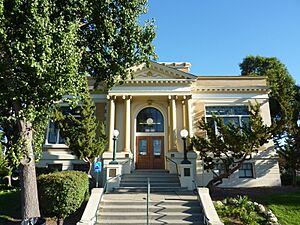
Livermore's culture still has some of its old farming and ranching traditions. But now, it's mostly a suburban community. Every June since 1918, Livermore hosts the Livermore Rodeo. It's called the "World's Fastest Rodeo." Many wine-tasting tours happen in the summer.
Livermore has different neighborhoods. Springtown is in the northeast. It was first planned as a retirement community. Now, it has many young families. The South Livermore area has over 40 wineries. Livermore also has a farmers market on Thursdays.
The first Camp Wonder opened in Livermore in 2001. This is a summer camp for children with special medical needs. In 2019, a local LGBT organization called Livermore Pride was founded. Livermore was also named an All-America City in 2021. This award recognizes communities that work together to solve problems.
The official city flower is the Livermore tarplant. This is an endangered plant that only grows near Livermore.
The World's Longest-Lasting Light Bulb
Livermore holds a world record for a light bulb! A 120-year-old light bulb, called the Centennial Light, is still burning. It's kept at the Livermore-Pleasanton Fire Department. It glows dimly, but it still works. The Guinness Book of World Records says it has been burning almost continuously since 1901. It only stopped for power outages or when it was moved.
Local Media
The radio station KKIQ broadcasts in the Tri-Valley area. The Independent is a local newspaper. It started in 1963.
Parks and Recreation in Livermore
The Livermore Area Recreation and Park District (LARPD) manages parks and facilities. It was created in 1947. LARPD has its own board of directors.
As of 2013, LARPD runs 42 facilities. These include over 1,842 acres of land. They offer many classes on different topics. LARPD serves about 115,000 people.
The area around Livermore has a lot of gravel. This has led to gravel mining. Shadow Cliffs Park is a popular park. It has an 80-acre lake in an old gravel pit. People use it for swimming, boating, and fishing.
Education in Livermore
Public Schools in Livermore
Public schools in Livermore are part of the Livermore Valley Joint Unified School District (LVJUSD). The district has 11 elementary schools. It also has three middle schools and two main high schools. There are also three alternative high schools.
A five-member Board of Education leads the LVJUSD. These members are elected by the community.
The Hertz Foundation for scholarships is also based in Livermore.
Changes to Charter Schools
Livermore used to have two charter schools. These were Livermore Valley Charter School (K-8) and Livermore Valley Charter Preparatory (high school). Both were run by the Tri-Valley Learning Corporation.
However, these schools closed down by the 2018 school year. This happened due to problems like not paying rent or teachers. Students from these schools went to other local schools.
Getting Around Livermore
Transportation Options
Interstate 580 is the main freeway that goes east and west through Livermore. It goes through the Altamont Pass to the Central Valley. I-580 is a key route for trucks traveling between the San Francisco Bay Area and Los Angeles. Interstate 680 is about 10 miles west of Livermore. Highway 84 goes southwest from I-580. Vasco Road connects Livermore to Brentwood.
The Livermore Municipal Airport (LVK) is about 3 miles northwest of the city. It is owned by the City of Livermore. About 600 aircraft are based there. The airport has over 150,000 take-offs and landings each year. It serves private and business planes. The airport has a main runway that is 5,250 feet long. An air traffic control tower operates daily. There is also an annual airshow in October. It features vintage World War II aircraft.
The WHEELS bus system serves Livermore. It also connects to Bay Area Rapid Transit (BART) stations in Dublin and Pleasanton.
Livermore has two stations for the Altamont Corridor Express (ACE). This is a commuter train that runs from Stockton to the San Jose area. One station is at Vasco Road. The other is in downtown Livermore at its Transit Center. The Transit Center has a free parking garage. It also connects to the WHEELS bus system.
There was a plan to extend the Bay Area Rapid Transit (BART) system to Livermore. But in 2018, the BART board voted against it. Instead, a new rail service called Valley Link is being planned. It will connect the existing BART system to the Altamont Corridor Express.
Police and Fire Services
The Livermore Police Department (LPD) started in 1876. It was one of the first police forces in the Bay Area. The LPD has 135 members, including 90 police officers.
The Livermore-Pleasanton Fire Department provides fire and medical services. It serves both Livermore and Pleasanton. It covers about 44 square miles. In 2008, the fire department responded to about 11,000 calls.
Famous People from Livermore
General Figures
- Tara Kemp, pop/soul singer
- Sonny Barger, outlaw biker and actor
- Bob Beers, Nevada state senator
- Robert Livermore, the city's namesake
- Jean Quan, former mayor of Oakland
- Hans Mark, physicist and former United States Secretary of the Air Force
- Ralph Merkle, pioneer in modern cryptography
- Brandon Rogers, comedian, actor and YouTuber
- George H. Miller, director of Lawrence Livermore National Laboratory
- Edward Teller, physicist and director of Lawrence Livermore National Laboratory
- Herb York, first director of Lawrence Livermore National Laboratory
- Harold Brown, director of Lawrence Livermore National Laboratory and former United States Secretary of Defense
- Conrad Bain (1923–2013), actor in Diff'rent Strokes
- Connie Post, first poet laureate of Livermore
- Bill Owens, photographer known for his book Suburbia
- Vanessa Ray, actress known for her role in Blue Bloods
Sports Stars
- Kristin Allen, World Games gold medalist gymnast
- Michael Rodrigues, World Games gold medalist gymnast
- Max Baer, heavyweight champion boxer
- Mark Davis, Major League Baseball pitcher
- Randy Johnson, Major League Baseball pitcher, Baseball Hall of Fame inductee
- Bryan Shaw, Major League Baseball pitcher
- J. R. Graham, Major League Baseball pitcher
- Bill Mooneyham, Major League Baseball pitcher
- Brian Johnson, Major League Soccer player
- Troy Dayak, Major League soccer player
- Duane Glinton, Turks and Caicos Islands national football team midfielder
Livermore's Sister Cities
Livermore has three sister cities. These are cities in other countries that have special friendships with Livermore:
 Quetzaltenango, Guatemala
Quetzaltenango, Guatemala Snezhinsk, Russia. People from Snezhinsk have visited Livermore.
Snezhinsk, Russia. People from Snezhinsk have visited Livermore. Yotsukaidō, Japan. Livermore and Yotsukaido have a student exchange program.
Yotsukaidō, Japan. Livermore and Yotsukaido have a student exchange program.
Resources About Livermore
- Livermore (2002), a film by Rachel Raney and David Murray
- Suburbia, a photo essay by Owens, Bill (1972), ISBN: 1-881270-40-8
See also
 In Spanish: Livermore (California) para niños
In Spanish: Livermore (California) para niños






